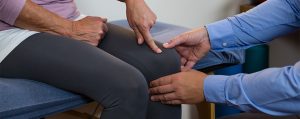PT-Approved Resolutions to Add to Your List
It’s that time of year again! The new year is just around the corner, which means many will create resolutions and set goals for the upcoming year. I want you to reflect on the goals you set last year. How did they go? How many did you accomplish? If you didn’t quite achieve what you wanted, why was that? Reflecting on what worked and didn’t work for you is key to understanding how to improve your behaviors this upcoming year. In this blog, I will lay out a few resolutions that I think everyone should have on their list this year, and I plan to make it easy to follow and implement so you will have some guaranteed goals to hit to give you momentum throughout the year.
4 Tips For A Successful Work Conditioning Program
The U.S. Bureau of Labor Statistics states that over 2.8 million worker compensation claims are filed annually. Many of the people who get hurt on the job will likely experience physical therapy for some period of time. The severity of the injury and the length of time you are away from your job will help determine if you are a candidate for going into a Work Conditioning Program.
3 Habits For A Healthy Heart
Heart Disease kills between 650,000 and 700,000 people every year. The American Heart Association (AHA) estimates that about 90% of these deaths were preventable through education and action. Having a healthy heart (outside genetic issues) takes work and some thoughtfulness. Here are some healthy habits you can do to get your ticker in shape and potentially add years to your life.
What Workout Is Right For You?
You can choose to go down many different paths within the fitness realm. Even if you are well-versed, switching up your workout routine can provide great health benefits and keep physical activity engaging if you are tired of the same old routine. The plethora of choices can be overwhelming, but this quiz is a helpful tool to determine which type of exercise you should try out for yourself.
3 Health Resolutions That Can Help You Build Healthy Habits All Year Long
Over the past few months, you may have noticed that gyms have become overcrowded, healthy and fresh foods are snatched up at grocery stores like hotcakes, and people furiously write down their New Year Resolutions. If you’re like the average person, you stick to these resolutions for a month or two before you ultimately drop them. For what reason? Most goals I see are too lofty and would benefit from some simplicity to maintain consistently.
The Link Between Exercise And A Strong Immune System
Exercise has been long established as a way to help boost immune function. For the general population, it is an easy way to get healthier and help prevent infections during cold and flu seasons and keep their immunity up throughout the year1. There is evidence that exercise can help decrease systemic swelling over time, which is a potent cause of disease and infection in humans, but if you look closer at the research, much of that is by way of excess body weight reduction, specifically visceral fat mass2. While exercise is good, too much can be detrimental to your immune system as well, in fact this is seen in many elite athletes by the frequency of upper respiratory tract infections they develop while training3.
Motion Is Lotion: How To Stay Moving When Living With Osteoarthritis
Arthritis affects 24% of American adults, is the leading cause of work disability1, and accounts for approximately $303 billion of the $4.1 trillion yearly healthcare cost. With 21% of the population estimated to be 65+ by 2030, arthritis management will be an increasingly prevalent topic.
While exercise is one of the best treatments for arthritis, inevitably, the question arises of how to keep moving when living with arthritis. The answer begins with understanding that exercise is not the enemy.
The Bare Hand Necessities for Grip Strength and Function
Tools and technologies can help complete our daily routines, but they are only as skillful as the user. In some instances, our bodies, specifically the hands, are the required tools, yet one might have physical limitations impeding performance and independence. Often, muscle weakness can be the main limiting factor for getting work done. To increase performance, improving one’s grip strength can be most beneficial.
